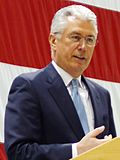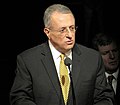 | Name: | Jeffrey R. Holland |
|---|
| Born: | (1940-12-03) December 3, 1940 (age 84) |
|---|
| Positions: | President of the Quorum of the Twelve Apostles, October 14, 2025 (2025-10-14) – present
Acting President of the Quorum of the Twelve Apostles, called by Russell M. Nelson, November 15, 2023 (2023-11-15) – September 27, 2025 (2025-09-27)
Quorum of the Twelve Apostles, called by Howard W. Hunter, June 23, 1994 (1994-06-23)
LDS Church Apostle, called by Howard W. Hunter, June 23, 1994 (1994-06-23)
First Quorum of the Seventy, called by Ezra Taft Benson, April 1, 1989 (1989-04-01) – June 23, 1994 (1994-06-23)
|
|---|
| Notes: | A former president of Brigham Young University. |
|---|
 | Name: | Dieter F. Uchtdorf |
|---|
| Born: | (1940-11-06) November 6, 1940 (age 85) |
|---|
| Positions: | Quorum of the Twelve Apostles, January 2, 2018 (2018-01-02) – present
Second Counselor in the First Presidency, called by Thomas S. Monson, February 3, 2008 (2008-02-03) – January 2, 2018 (2018-01-02)
Quorum of the Twelve Apostles, called by Gordon B. Hinckley, October 2, 2004 (2004-10-02) – February 3, 2008 (2008-02-03)
LDS Church Apostle, called by Gordon B. Hinckley, October 7, 2004 (2004-10-07)
Presidency of the Seventy, called by Gordon B. Hinckley, August 15, 2002 (2002-08-15) – October 2, 2004 (2004-10-02)
First Quorum of the Seventy, called by Gordon B. Hinckley, April 7, 1996 (1996-04-07) – October 2, 2004 (2004-10-02)
Second Quorum of the Seventy, called by Ezra Taft Benson, April 2, 1994 (1994-04-02) – April 7, 1996 (1996-04-07)
|
|---|
| Notes: | The first apostle of German descent. |
|---|
 | Name: | David A. Bednar |
|---|
| Born: | (1952-06-15) June 15, 1952 (age 73) |
|---|
| Positions: | Quorum of the Twelve Apostles, called by Gordon B. Hinckley, October 2, 2004 (2004-10-02)
LDS Church Apostle, called by Gordon B. Hinckley, October 7, 2004 (2004-10-07)
|
|---|
| Notes: | Final president of Ricks College and first president of Brigham Young University–Idaho. |
|---|
 | Name: | Quentin L. Cook |
|---|
| Born: | (1940-09-08) September 8, 1940 (age 85) |
|---|
| Positions: | Quorum of the Twelve Apostles, called by Gordon B. Hinckley, October 6, 2007 (2007-10-06)
LDS Church Apostle, called by Gordon B. Hinckley, October 11, 2007 (2007-10-11)
Presidency of the Seventy, called by Gordon B. Hinckley, August 1, 2007 (2007-08-01) – October 6, 2007 (2007-10-06)
First Quorum of the Seventy, called by Gordon B. Hinckley, April 5, 1998 (1998-04-05) – October 6, 2007 (2007-10-06)
Second Quorum of the Seventy, called by Gordon B. Hinckley, April 6, 1996 (1996-04-06) – April 5, 1998 (1998-04-05)
|
|---|
 | Name: | Neil L. Andersen |
|---|
| Born: | (1951-08-09) August 9, 1951 (age 74) |
|---|
| Positions: | Quorum of the Twelve Apostles, called by Thomas S. Monson, April 4, 2009 (2009-04-04)
LDS Church Apostle, called by Thomas S. Monson, April 9, 2009 (2009-04-09)
Presidency of the Seventy, called by Gordon B. Hinckley, August 15, 2005 (2005-08-15) – April 4, 2009 (2009-04-04)
First Quorum of the Seventy, called by Ezra Taft Benson, April 3, 1993 (1993-04-03) – April 4, 2009 (2009-04-04)
|
|---|
 | Name: | Ronald A. Rasband |
|---|
| Born: | (1951-02-06) February 6, 1951 (age 74) |
|---|
| Positions: | Quorum of the Twelve Apostles, called by Thomas S. Monson, October 3, 2015 (2015-10-03)
LDS Church Apostle, called by Thomas S. Monson, October 8, 2015 (2015-10-08)
Presidency of the Seventy, called by Gordon B. Hinckley, August 15, 2005 (2005-08-15) – October 3, 2015 (2015-10-03)
First Quorum of the Seventy, called by Gordon B. Hinckley, April 1, 2000 (2000-04-01) – October 3, 2015 (2015-10-03)
|
|---|
 | Name: | Gary E. Stevenson |
|---|
| Born: | (1955-08-06) August 6, 1955 (age 70) |
|---|
| Positions: | Quorum of the Twelve Apostles, called by Thomas S. Monson, October 3, 2015 (2015-10-03)
LDS Church Apostle, called by Thomas S. Monson, October 8, 2015 (2015-10-08)
Presiding Bishop, called by Thomas S. Monson, March 31, 2012 (2012-03-31) – October 9, 2015 (2015-10-09)
First Quorum of the Seventy, called by Thomas S. Monson, April 5, 2008 (2008-04-05) – March 31, 2012 (2012-03-31)
|
|---|
 | Name: | Dale G. Renlund |
|---|
| Born: | (1952-11-13) November 13, 1952 (age 73) |
|---|
| Positions: | Quorum of the Twelve Apostles, called by Thomas S. Monson, October 3, 2015 (2015-10-03)
LDS Church Apostle, called by Thomas S. Monson, October 8, 2015 (2015-10-08)
First Quorum of the Seventy, called by Thomas S. Monson, April 4, 2009 (2009-04-04) – October 3, 2015 (2015-10-03)
|
|---|
 | Name: | Gerrit W. Gong |
|---|
| Born: | (1953-12-23) December 23, 1953 (age 71) |
|---|
| Positions: | Quorum of the Twelve Apostles, called by Russell M. Nelson, March 31, 2018 (2018-03-31)
LDS Church Apostle, called by Russell M. Nelson, April 5, 2018 (2018-04-05)
Presidency of the Seventy, called by Thomas S. Monson, October 6, 2015 (2015-10-06) – March 31, 2018 (2018-03-31)
First Quorum of the Seventy, called by Thomas S. Monson, April 3, 2010 (2010-04-03) [12] [13] – March 31, 2018 (2018-03-31)
|
|---|
| Notes: | The first apostle of Asian descent. |
|---|
 | Name: | Ulisses Soares |
|---|
| Born: | (1958-10-02) October 2, 1958 (age 67) |
|---|
| Positions: | Quorum of the Twelve Apostles, called by Russell M. Nelson, March 31, 2018 (2018-03-31)
LDS Church Apostle, called by Russell M. Nelson, April 5, 2018 (2018-04-05)
Presidency of the Seventy, called by Thomas S. Monson, January 6, 2013 (2013-01-06) – March 31, 2018 (2018-03-31)
First Quorum of the Seventy, called by Gordon B. Hinckley, April 2, 2005 (2005-04-02) – March 31, 2018 (2018-03-31)
|
|---|
| Notes: | The first apostle of Brazilian descent. |
|---|
 | Name: | Patrick Kearon |
|---|
| Born: | (1961-07-18) July 18, 1961 (age 64) |
|---|
| Positions: | Quorum of the Twelve Apostles, called by Russell M. Nelson, December 7, 2023 (2023-12-07)
LDS Church Apostle, called by Russell M. Nelson, December 7, 2023 (2023-12-07)
Presidency of the Seventy, called by Thomas S. Monson, August 2017 (2017-08) – December 7, 2023 (2023-12-07)
First Quorum of the Seventy, called by Thomas S. Monson, April 3, 2010 (2010-04-03) – December 7, 2023 (2023-12-07)
|
|---|
 | Name: | Gérald Caussé |
|---|
| Born: | (1963-05-20) May 20, 1963 (age 62) |
|---|
| Positions: | Quorum of the Twelve Apostles, called by Dallin H. Oaks, November 6, 2025 (2025-11-06)
LDS Church Apostle, called by Dallin H. Oaks, November 6, 2025 (2025-11-06)
Presiding Bishop, called by Thomas S. Monson, October 9, 2015 (2015-10-09)
First Counselor in the Presiding Bishopric, called by Gary E. Stevenson, March 31, 2012 (2012-03-31) – October 9, 2015 (2015-10-09)
First Quorum of the Seventy, called by Thomas S. Monson, April 5, 2008 (2008-04-05) – March 31, 2012 (2012-03-31)
|
|---|
| Notes: | The first apostle of French descent. |
|---|













